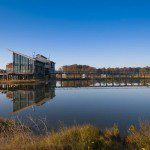Georgetown’s Dale Overmyer
By • November 5, 2015 0 4556

Dale Overmyer is a star architect in Georgetown. His tailored suit goes with the role, but his modest, soft-spoken demeanor seems out of place when he’s discussing the 100-plus renovations he’s done in Georgetown, the homes he has built in Palm Beach and the Hamptons and the architectural work he has done for Georgetown engineering executive Bill Dean, a.k.a. the “Jay Gatsby of Miami.” (Dean hired Overmyer to design both his Oyster House in Virginia’s Northern Neck and Terra Veritatis, his 11-bedroom Mediterranean-style villa compound in Miami Beach.)
In Overmyer’s telling, he was born to build in Georgetown. His grandfather, a general contractor, passed on some carpentry skills to his father, who, says Overmyer, “was talented at drawing and painting but never pursued his artistic interests.” Overmyer was raised “with tremendous focus on art and drawing” — which came in handy growing up in West Africa without TV or radio. “Legos were the only toy I had,” he says.
As Overmyer got older, he became more and more interested in building things: forts and tree houses and go-carts. When he was 8 years old, his dad gave him a jigsaw. “Who gives their kids power tools at 8 years old?” he reflects now.
Born in Venezuela, Overmyer was always on the move with his family, which exposed him to breathtaking structures on several continents. He recalls being struck by architecture everywhere he traveled: by the majesty of Saint Basil’s Cathedral in Moscow, by the mix of modern and traditional architecture along the Angolan coast, by the urban landscape of London, by the monumental and symbolic buildings at Dulles Airport, by Georgetown’s history and character.
He came to the U.S. every year or so to visit his aunt, uncle and cousins on Reservoir Road in Georgetown, his “home in America.” That was when Overmyer fell in love with Georgetown.
Ultimately, his family moved back to the U.S., settling in Houston when he was 13. Overmyer stayed in the area through college — he earned his Bachelor of Architecture degree at the University of Texas — then moved to Georgetown with his wife Melissa “immediately after school.” For his thesis project, Overmyer had used Georgetown as a model for creating a pedestrian-based, sustainable community.
While other architects may shy away from working in Georgetown, fearing the seemingly all-powerful Old Georgetown Board, Overmyer cherishes the challenges. “A lot of people consider it to be a real briar patch, but it’s my briar patch and I really enjoy it,” he says of the process of building and renovating homes in Georgetown. Though the rules can be burdensome, “they have made Georgetown, and kept it, a good place.”
Lately, Overmyer has been dealing with the Old Georgetown Board on his own behalf, proposing renovations for his family’s new home on S Street. “The Old Georgetown Board described the new home as ‘a dog’s breakfast of a house,’ which only makes me happy, because I love potential,” he says with a smile.
The new digs provide more room for his kids — ages 9, 19, 21 and 23 — and there is a first-floor master bedroom to accommodate him and his wife as they age. (Plus, it has a parking space, a hot commodity in Georgetown.)
Excerpts from The Georgetowner’s recent interview with Overmyer, edited for clarity, appear below.
The Georgetowner: How do you approach the renovation of an older home in a historic district? Is the process limiting?
Dale Overmyer: It’s limiting, but it’s also educational. Everyone that lives in a house exerts some influence on it. We try to draw out things that are unique and creative about our clients with the architecture we do — of course, being mindful of the people that came before them and their expressions.
It must be an intimate process.
It really is. When we work, we want to understand how our clients want to live in their house. We think about who is in there, how many people and what are they doing. We want your environment to perfectly fit your lifestyle.
That information must be important when you’re building a house from scratch too, right?
When we build something new, we are looking back into our clients’ childhood dreams and fantasies. We imagine what a beautiful place to live in the new home could be. It’s really more of a guide service. We want to take people to places they’ve dreamed about but where they can’t take themselves. We want to take them farther than they imagined.
Who is your typical client?
Our typical client is somebody who always wanted to be an architect themselves. That is almost universally true. The typical client is someone who has been very successful and is very interested in being creative, but they are usually in a field that doesn’t yield the kind of creativity that they like. So they enjoy the creative process of design and building, and it gets that inner architect out of their system. We really enjoy working collaboratively with clients to draw out as much experience, talent and creativity as possible. It just enriches the project.
If they have the capacity, what people find is that investing in good buildings is a good investment. It’s one they can enjoy personally and it adds value to their portfolio. If they can, they build as much as they can. It’s an expensive pastime but it’s a good investment.
What is the typical project in Georgetown like?
A lot will just have a small addition and need a lot of interior work. A house will really need to have a complete reworking every 50 years, especially if it hasn’t really had infrastructure done in the 20th century. Some previous owners have gotten away with doing very little in terms of air conditioning and plumbing. So we do a lot of gut jobs.
In addition, some homes in Georgetown have been carved into the tiniest little rooms. Our effort is often to simplify those small, cramped spaces into fewer, bigger, simpler spaces. Fewer, bigger, simpler is my mantra.
And what are the usual results?
One of the things we do a lot of work on is rewriting the social equation for modern living. Since the late part of the 20th century, Americans moved into more informal lifestyles. We do our own cooking and we do our own cleaning now. Congregating in the house typically happens around meals, so the family room and the kitchen are really the new heart of the home. Those rooms used to be hidden away and given as little space as possible. Now they are the main area of living in the house. So we are rewriting a formula to respond to how people live now.
In fact, I just interviewed for Julia Child’s house. I don’t have that job yet, but I would love to play out the possibilities there, because shows like hers turned the act of preparing a meal into part of the entertainment and the kitchen into a community space. That would be a neat way to tie up a lot of the things that have kept me busy over the years.
What is your favorite house in Georgetown that you haven’t worked on?
We are basically living in a museum. And the museum has so much variety of time and style. It’s entertaining that many houses are similar, but every one is absolutely unique and has a story to tell and has usually been taken care of by people that love them. I think of the whole neighborhood being the real gem.
I describe it as a quaint village within a big city. It has the best of both worlds. It has everything that a child or teenager or student or young adult or someone in their midlife or someone aging in place could want. It’s a vital and relevant community wherever you are in life. It also has probably the most interesting collection of citizens past and present of any neighborhood in the world.
I’ve always lived and worked in Georgetown. That’s the model for how people should live.
- Dale Overmyer in his office. | Jai Williams
- John Rose / NPR
- Jordan Wright





